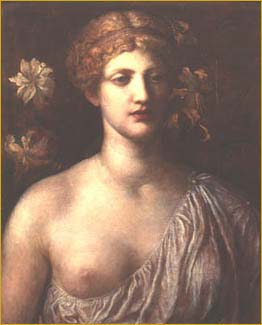
The Wife of Pygmalion
1817-1904
Signed and inscribed on a label on the stretcher No.3 The Wife of Pygmalion/ G.F. Watts/Little Holland House/Kensington Oil on canvas 26 1/4 ins by 21 ins
Collection Details
T Eustace Smith, 1873 and 1882; 1st Lord Faringdon by 1905; included in his sale, Sotheby’s, 13 June 1934, lot 136, when it was bought by Lord Faringdon.
Literature
M S Watts, Watts, 1912, i, pp.236–8.
Exhibition Details
RA, 1868, No. 323; London, International Exhibition, 1873, No.1026; Grosvenor Galleries, London, 1881, No.55; New Gallery, London, 1896, No.77; RA, Winter, 1905, No.53; Arts Council, Tate, Watts, 1954, No.45; Whitechapel Art Gallery, Watts, 1974, No.23; Manchester City Art Gallery, Minneapolis Institute and Brooklyn Museum, Victorian High Renaissance, 1978, No.17.
Background
A label on the back is inscribed: No.3. The Wife of Pygmalion G. F. Watts, Little Holland House, Kensington.
M S Watts relates that Gladstone had expressed a wish to own this picture after seeing it at the Academy in 1868. In a letter to Gladstone, dated 3 May 1868, informing him that it was ‘claimed’, Watts wrote deprecatingly of the painting and invited Gladstone to visit him in order to see the cast of the fragmentary Greek original from which it derived (in the RA exhibition, the work was entitled ‘A Translation from the Greek’).
Watts had discovered the head and torso separately among the Arundel Marbles when visiting the Ashmolean some years before with Sir Charles Newton. The cast that he had made from it always stood in his studio. (For a full account of the picture, see 1978 exhibition catalogue.)
The Trustees of the Faringdon Collection 26.
All rights reserved.
